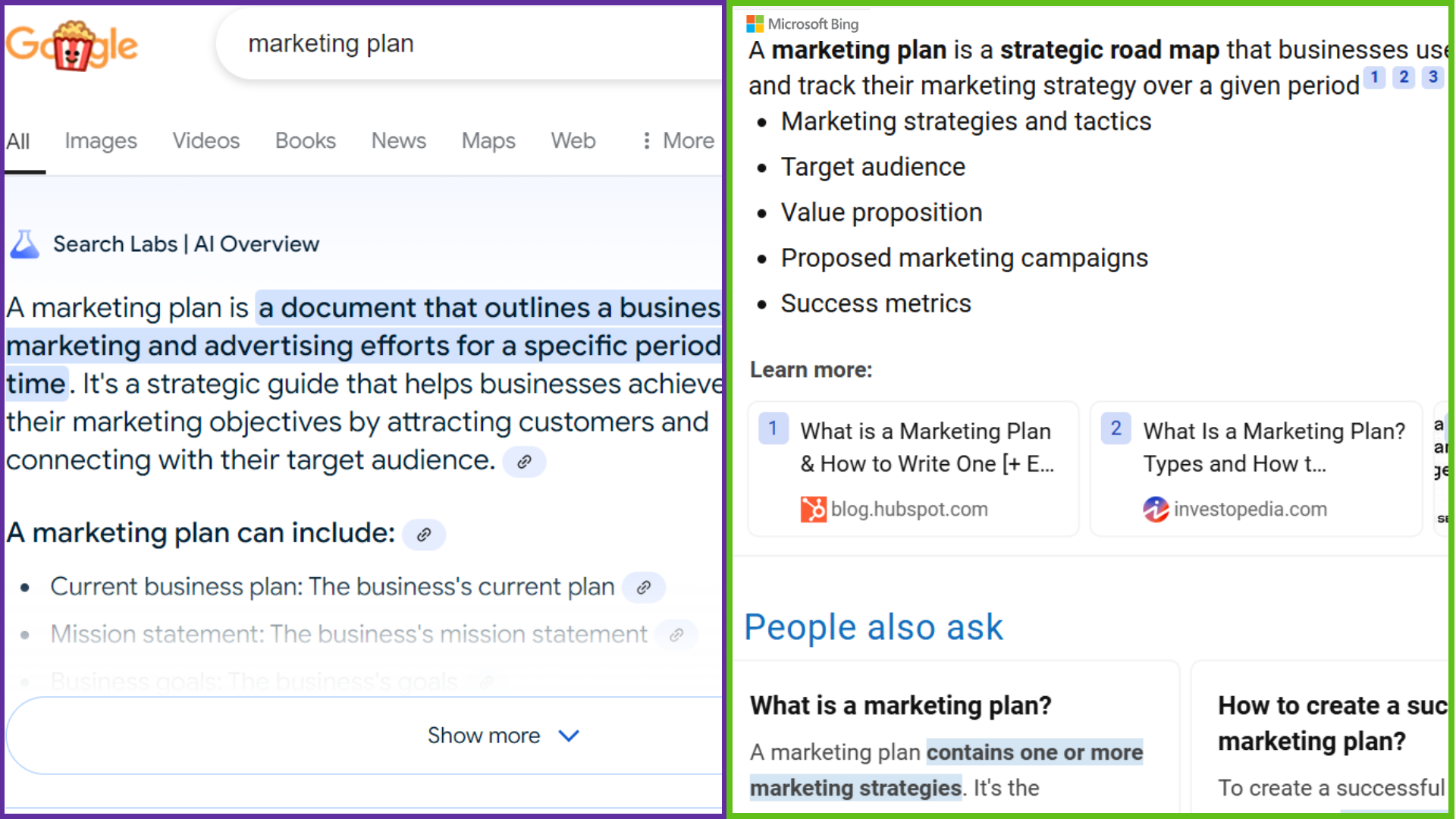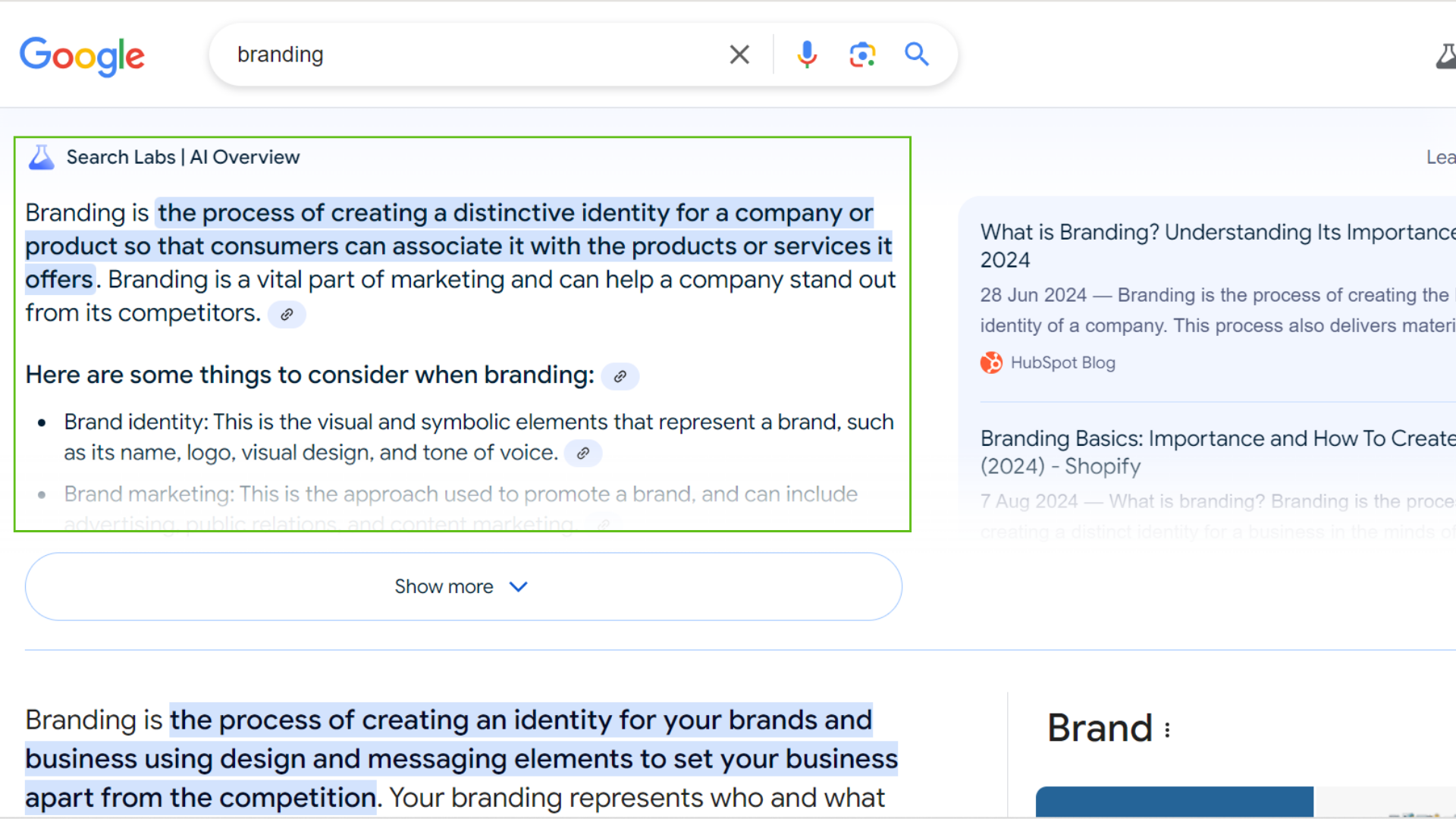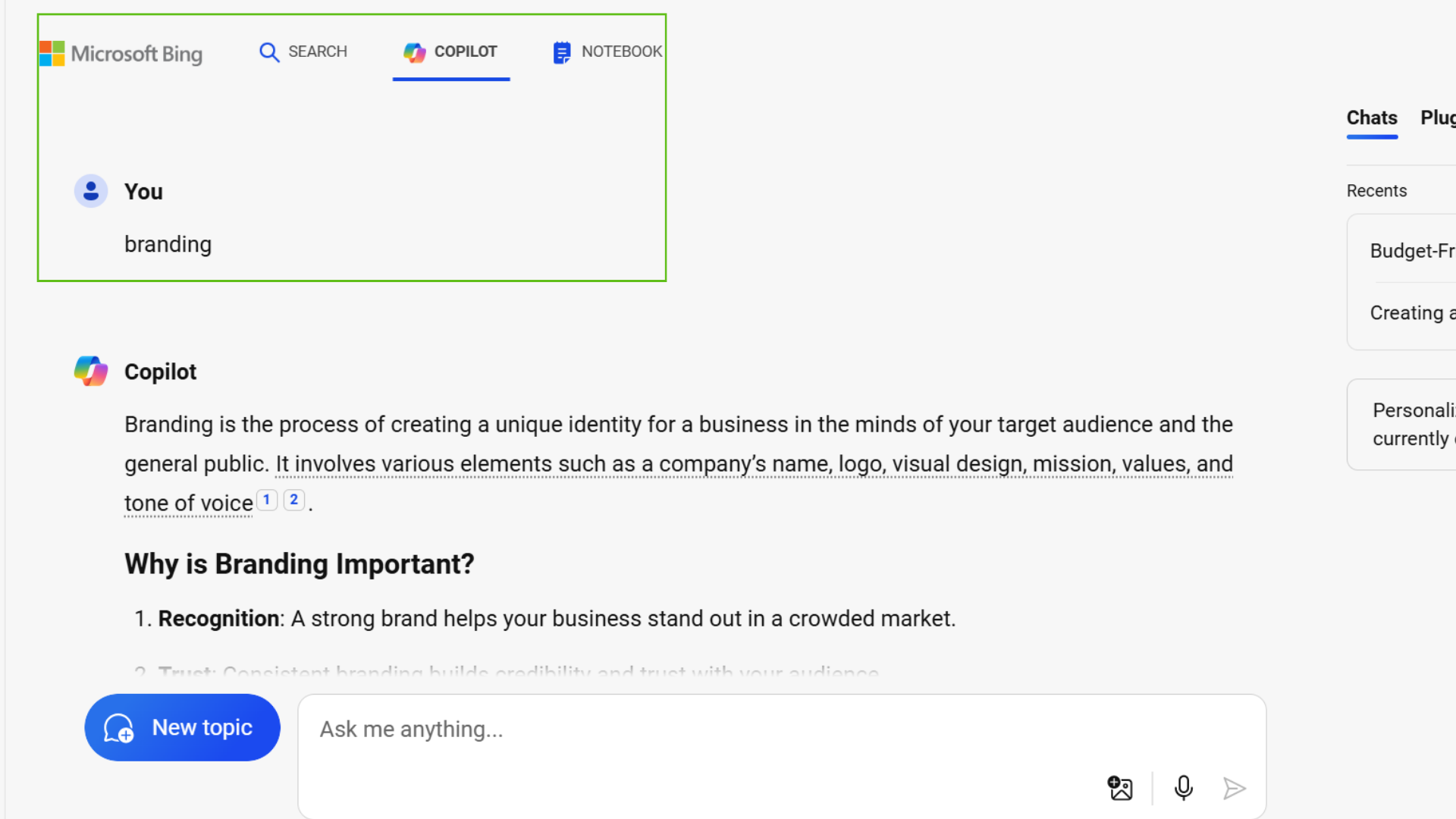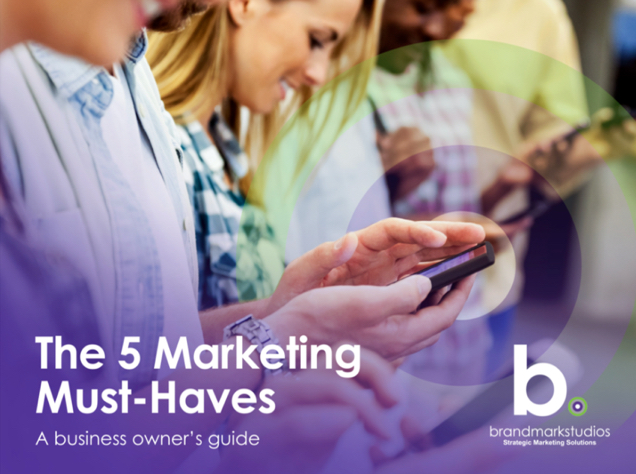This level of automation has changed how marketers approach content strategy, offering new ways to scale and streamline their efforts
But with these advancements come questions. How does AI-generated content impact search engine rankings? And with AI now embedded in search algorithms and SERPs (Search Engine Results Pages), what does this mean for the future of SEO?
In this article, we’ll consider both sides: the impact of AI on content creation and its integration into search engines.
What is generative AI and AI-generated content?
Generative AI is a branch of artificial intelligence that creates new content, such as text, images, or music, based on learning from existing data.
AI-generated content is essentially any type of content produced by artificial intelligence, encompassing anything from written articles to synthetic images.
Generative AI relies on sophisticated models like GANs (Generative Adversarial Networks) and transformer-based models to generate content that often resembles human-created work. While it offers potential for innovation and efficiency, it also presents challenges around ethics, copyright, and the impact on creative industries.
Can AI-generated content hurt your search ranking?
The short answer is no. Search engines like Google will not penalize AI-generated content. However, they are cracking down on low-quality or spammy content, regardless of how it’s produced. So, if your AI-generated content is thin, inaccurate, or fails to provide users value, it can hurt your rankings.
Google emphasizes the importance of high-quality, user-first content that aligns with its E-E-A-T guidelines: Experience, Expertise, Authoritativeness, and Trustworthiness. This applies whether humans or AI creates the content.

How does Google detect AI content?
While not 100% accurate, Google is able to detect AI content using a mix of advanced algorithms, machine learning, and natural language processing to spot patterns that differentiate machine-generated text from human writing.
AI-generated content often has repetitive phrases or lacks the natural flow of human expression, and Google's tools are able to pick up on these subtle differences. Google will also compare new content with what’s already online, flagging any similarities or duplication.
Common mistakes businesses make with AI-generated content
Mistake #1 - Duplicate content: AI tools can generate repetitive or near-identical content, leading to issues like keyword cannibalization and duplication penalties from search engines. If multiple pages offer the same or highly similar text, Google may devalue them in the rankings.
Mistake #2 - Keyword stuffing: AI can sometimes over optimize by inserting too many keywords in a way that feels unnatural. This can trigger a penalty, as Google penalizes sites that try to manipulate rankings by overusing specific terms. AI tools are prone to placing keywords that negatively impact readability and user experience.
Mistake #3 - Thin content: Google’s algorithms avoid ranking low-quality, “thin” content—pages that offer little value to the user. AI-generated content often falls into this trap, as it may lack depth, originality, or valuable insights. Content with minimal word count or poor substance is viewed as low-value and can lead to lower rankings or even a penalty.
Mistake #4 - Low-quality content: AI-generated content may contain factual errors, lack coherence, or fail to meet the user’s search intent. Without human oversight, these issues will negatively impact user experience and result in penalties. Google favors accurate, authoritative, and relevant content, so human input is essential to fine-tune and verify AI outputs.
9 tips for using AI-generated content in your articles:
- Engage AI with specific scenarios: If you want content tailored to your needs, describe a very specific scenario or situation.
Example: "Imagine you're a content marketer at Brandmark Studios writing an article about a new product feature."
- Specify the content format: Clearly state if you need the content in a specific format.
Example: "The article should be formatted as a blog article which will be released on Brandmark Studios’ website."
- Set the tone: Indicate the desired mood or tone of the content.
Example: "The article should be produced in a way that is professional but also light-hearted."
- Define the audience: Be explicit about the target audience.
Example: "Craft the article in a way that resonates with small business owners in the tech industry, located in the United States."
- Limit your length: If you need concise answers or summaries, mention your word count preference or request a brief explanation.
- Use open-ended questions: For more detailed responses, phrase your prompts as open-ended questions.
- Provide context: Background information helps generate more accurate content. If your prompt continues a previous topic or provides a unique context, include it.
- Ask for multiple angles: When uncertain about the direction of the content, request multiple perspectives.
Example: "Offer three different introduction variations for this article."
- Review and refine: Understand that AI outputs may require adjustments for brand voice, accuracy, and relevance. Use the generated content as a starting point for refinement by professional writers.
Generative AI-powered search
Generative AI is transforming search engines like Google and Bing, changing how search results are delivered and impacting SEO strategies. These platforms now use AI to generate detailed, conversational responses directly in search results, offering users synthesized information from multiple sources.
Instead of simply providing a list of links, AI-powered engines aim to deliver detailed, conversational answers directly within the search results.

Search Features That Present the Most Significant Changes to SERPs and CTRs
Generative AI has introduced several features that are transforming SERPs and significantly affecting CTRs:
Direct Response Snapshots
Direct response snapshots offer bite-sized, AI-generated answers right at the top of SERPs. These concise, well-structured responses summarize key information from various sources, allowing users to get immediate answers without clicking external links.
While this improves user experience, it can reduce organic traffic to websites since fewer users will click through if their query is already answered on the search page.

Embedded Conversational Interfaces
Conversational interfaces embedded within search engines act like chatbots, allowing users to refine queries in real time, receive more personalized responses, and reduce the need to navigate through multiple pages.
The interface feels more interactive, mirroring a human conversation.

More Options and Suggestions
AI-powered engines provide users with expanded options and recommendations during their searches. Google and Bing suggest related questions, potential follow-up queries, or alternate ways to phrase the search.
This enriches the search experience, giving users more control and refining their results, but it also creates more competition for visibility.

How marketers can optimize websites for AI-powered search engines
As AI-powered search engines like Google’s SGE (Gemini) and Microsoft’s Bing AI become more popular among user’s searches, marketers need to adjust their SEO strategies to stay competitive.
Here’s how:
- Focus on high-quality, authoritative content: AI pulls from trusted sources. Ensure your content is factual, in-depth, and offers real value.
- Optimize for featured snippets and structured data: Use clear, concise answers and schema markup to help AI extract key information.
- Leverage conversational keywords: Incorporate natural, conversational language to align with AI’s more interactive and question-based searches.
- Improve content depth: AI favors content that thoroughly answers a query. Long-form content that addresses various aspects of a topic can be more appealing to AI-powered engines.
- Stay updated on AI trends: As AI-driven search evolves, you need to keep up with new features and changes, like voice search optimization or new algorithms that could affect rankings.
How to write unique content for SEO
Focus on Unique Keywords
Keyword research can serve as the foundation for unique content. By identifying low-competition, long-tail keywords, you can ensure your content is tailored to a smaller but highly relevant set of searches.
Provide Content Unique to Your Brand
Originality is critical for both user engagement and SEO. Focus on producing content that offers fresh perspectives or data that competitors may not provide. Personal insights, case studies, or creative storytelling are great ways to make your content stand out.
Focus on a Specific Niche and Target Target Audience
By narrowing down your focus for your content, you can tailor your messaging to address the precise needs, questions, and interests of a well-defined group, thus helping to improve engagement and credibility.
Address Search Intent
Understand search intent and match your content to the intent behind your target keywords. Your content should solve the specific problem or answer the question that users are looking to address. This helps to ensure your content is high quality and targeted to a specific reader, helping you to stand out amongst a sea of similar content.
Utilize Your Company’s Tone of Voice
Your tone of voice is a powerful tool for creating content that stands out. By establishing and consistently using a unique and authentic tone, you’ll be able to add a layer of authenticity to your content, making it more memorable and trustworthy to both readers and search engines.
Final Thoughts
The rise of AI-powered search engines, like Gemini and Bing AI, is fundamentally reshaping SEO. Marketers now face a world where AI-generated answers, conversational interfaces, and direct response snapshots are becoming the norm.
This shift affects content rankings and CTR, with users increasingly finding their answers without clicking through to individual websites. To stay competitive, businesses must create high-quality, structured, conversational content that aligns with AI’s capabilities.
Adapting to this evolving landscape requires staying proactive and ensuring that content is optimized for traditional SEO and the AI-driven, interactive future of search. By prioritizing authority, relevance, and engagement, businesses can position themselves to thrive in this AI-dominated search ecosystem.
If you’re looking for professional help when it comes to navigating the challenges of AI generated content for your SEO strategy, Brandmark Studios is here to help! Contact us today!










